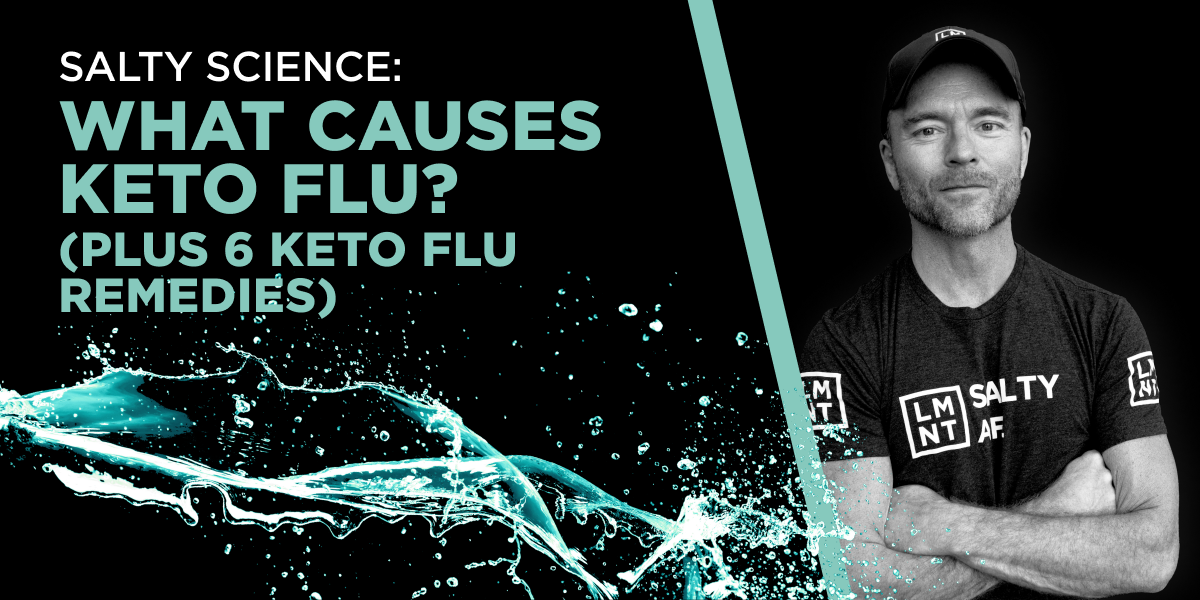A strange set of symptoms afflict low-carb dieters. These symptoms — a mix of headaches, fatigue, weakness, irritability, muscle cramps, and insomnia — have been dubbed “the keto flu.” While they’re most prominent during the early days of a ketogenic diet, their fingerprints can be felt for a long time if the causes are not addressed.
The keto flu is a bit of a dark horse. Most medical journals don’t mention it. Even the keto community can’t agree on what causes it. One article blames dehydration, another carb withdrawal, another a lack of fiber. “Just give it time” is the typical advice.
Sure, it’s possible that your symptoms will improve with time. But if your keto flu is caused by low sodium, a more common trigger than most people realize, waiting will only make things worse. Your body responds to sodium deficiency by decreasing blood volume, which can induce dehydration despite your chugging water. Not to mention, overconsuming plain water can exacerbate the symptoms of sodium deficiency by diluting blood sodium levels.
I’m not saying that increasing sodium intake will resolve the keto flu for everybody. There isn’t just one cause. However, it is the step that people overlook most. You’ll have to do a little detective work to solve your keto flu. I wrote this article as your guide. Keep reading to learn the most likely causes of keto flu and how to fix them.
What Is The Keto Flu?
The keto flu is not a tropical illness, it’s a catchy label for the set of symptoms linked to going keto. The most common keto flu symptoms are:
- Brain fog
- Headache
- Constipation
- Muscle cramps
- Diarrhea
- Weakness
- Fatigue
- Irritability
With this set of symptoms, you can easily see why “flu” was the ailment selected to name this condition. These symptoms tend to occur within the first few days of eating a keto diet, but this isn’t a hard rule. Some people feel lousy months into the program.
Causes of Keto Flu
The keto flu is a product of change. When you eliminate most carbs, you minimize blood sugar spikes, keeping insulin levels low. Low insulin levels tell your body to begin breaking down body fat into fatty acids and producing ketones from them. Voila! The body shifts its primary source of energy to fat — be it dietary or body fat — and you’re in ketosis.
However, the human body is a complex machine, and medical issues rarely ever spring from a single root. Similarly, reducing your carbohydrate intake is bound to twist more than one dial. Let’s drill into five specific causes of the keto flu now, and then we’ll hit on remedies.
#1: Sodium deficiency
Sodium does more than make your eggs palatable. It facilitates nerve impulses, regulates fluid balance, and influences a variety of hormones. Without enough sodium, you won’t feel, perform, or sleep well. For example, low sodium increases norepinephrine, a stimulating hormone.
The symptoms of low sodium (headaches, muscle cramps, weakness, brain fog, insomnia, etc.) overlap significantly with the symptoms of keto flu. In fact, keto flu is most often a simple matter of sodium deficiency.
Remember how low-carb diets minimize the hormone insulin? Well, one of insulin’s lesser-known jobs is telling your kidneys to retain sodium. That’s why diabetics with hyperinsulinemia (high insulin) have problems with salt. All that insulin keeps them from peeing out sodium, which impairs their ability to regulate blood pressure.
Low-carb folks have the opposite issue. By minimizing insulin, they pee out too much sodium. Combine that with lower dietary intakes of sodium (less chips, crackers, etc.) and you have a recipe for keto flu.
#2: Dehydration
Dehydration (losing too much water) presents similarly to low sodium with symptoms like headaches, cramping, and low energy.
Well, guess what? The range of sodium in the blood which is conducive with staying alive is incredibly tight. If the body is shedding water it must shed sodium — and if it sheds sodium it must also shed water. So, you don’t just pee out more sodium on keto, but also more water.
This doesn’t mean you should start hydrating like a beached manatee. Overhydration will dilute blood sodium levels and exacerbate low sodium symptoms. Arbitrary advice such as “Drink X ounces of water per day” or “Chug a gallon of water every day” is simply bad advice given by well-meaning people.
It’s impressive how well the body communicates its needs. Listen to it! Drink electrolyte water to thirst, not beyond thirst.
#3: Carb withdrawal
I use the term “withdrawal” loosely here. While I wouldn’t argue that these foods are technically addictive, I also won’t gnash my teeth defending them. The fact of the matter is that a great deal of people struggle to reduce their intake of processed foods and simple sugars — and cutting out these empty calories is the lowest hanging fruit to reduce your overall carbohydrate intake.
“Similar to drugs of abuse,” write the authors of one paper, “glucose and insulin signal to the mesolimbic system to modify dopamine concentration.”
Translation: Depriving yourself of carbs (which your digestive system breaks into sugar) deprives you of dopamine-driven good feelings. There’s a reason so many comfort foods are a combination of fat and sugar.
If you were eating a high-carb diet before keto, there’s a good chance you could experience keto flu symptoms. Fortunately, you can slow down the blood sugar roller coaster, and eventually hop off of it entirely. Read this article for some tips to make the ride easier.
#4: Less brain fuel
When you eat carbs, your brain runs primarily on glucose. But when you reduce your carb intake, your body has to dust the cobwebs off of an old piece of metabolic machinery: ketogenesis.
You see, a ketogenic diet tells your body to break down fatty acids from dietary and body fat. These fatty acids undergo a series of modifications to create adenosine triphosphate (ATP) — little molecules of energy for your cells. But because fatty acids aren’t water-soluble, they cannot cross the blood brain barrier. They can’t be used as brain fuel.
Thankfully, ketogenesis also turns fatty acids into ketones, which are water soluble. These ketones can cross the blood brain barrier, convert to ATP, and fuel your brain with clean, efficient energy. But since your body is not used to running primarily on fat, it can take time to unlock the full potential of this metabolic pathway. Researchers believe this transition period — from relying on glucose to relying on ketones — may cause keto flu symptoms.
This process is called fat adapting (or keto adapting), and it’s distinct from ketosis. Read 4 ways to become fat adapted to expedite this process.
Top 6 Keto Flu Remedies
Now that you know the various potential causes of keto flu, you can try implementing the following remedies.
#1: Consume more sodium
Keto flu is very often a case of sodium deficiency. Consume more salt, and the symptoms melt away. Don’t take my word for it — experiment and see how you feel.
Salt your food twice as much as you would normally. Consume foods like pickles and olives. You’ll feel the difference when you get it right.
#2: Hydrate wisely
This goes hand-in-hand with the previous tip. Dehydration can cause keto flu symptoms, so it’s important to heed your thirst. But drinking past thirst could dilute blood sodium levels and worsen your symptoms.
Instead, try drinking salty water to thirst. We offer a zero sugar electrolyte drink mix, LMNT, with enough sodium to make a real difference in how you feel. This combined strategy should easily prevent keto dehydration.
#3: Try MCT oil
When you consume medium-chain triglycerides (MCTs), they travel straight to your liver for conversion to ketones. In other words, MCT oil can deepen your state of ketosis.
MCTs even work in the presence of carbs. This is a bit speculative, but MCTs — by elevating blood ketones — may help your brain adapt to the lack of glucose more quickly.
It’s worth noting that MCTs, like all fats, are quite calorie-dense and lack nutrients. So if fat loss is your goal, it may be a bad idea to chug MCTs indiscriminately. Also, if MCTs are a new supplement for you, it is wise to start slowly as they can introduce some gastric distress.
#4: Eat non-starchy veggies
Non-starchy veggies should provide the bulk of your carbohydrate intake on a keto diet. These plants provide the valuable vitamins, minerals, and fiber that are often harder to come by on the keto diet.
For starters, try low-carb veggies like kale, arugula, spinach, broccoli, lettuce, and asparagus. If it has under 5 grams of carbs per serving, it’s a fine choice. Quick caveat: Not everyone, especially those with existing gut issues, can tolerate tons of fiber. In these cases, a low-fiber diet can actually be therapeutic while the gut heals.
#5: Consider carb cycling
Having carbs is not a sin. On days when I am training heavily for more than an hour, I tend to add more carbohydrates to fuel the session. I don’t need carbs, per se. I just have better energy if I take 5-10 grams of glucose during intense sessions. If my training goes on for 2 hours, I may double this.
Another form of carb cycling is to eat more carbs (around 75–150 grams) for one or two days per week. These are not the days to overindulge with candy bars and ice cream. Instead, get in some healthy potatoes, tubers, and rice. I will admit that I’m not a big fan of this type of carb cycling, as I think it can introduce as many problems as it resolves. But for active individuals, more carbohydrates can often be tolerated.
Finally, keto is not the “single best diet” for everyone. Eating 75 to 150 grams of carbs per day may be a better approach for you. This is close to the approach recommended in my book Wired To Eat as part of my 30 Day Reset Diet.
#6: Supplement electrolytes
The latest scientific literature suggests that 4–6 g sodium, 3.5–5 g potassium, and 400–600 mg magnesium each day is optimal. People who exercise and eat a low-carb diet may need even more sodium, in particular.
You can hit these numbers any way you like. I used to make homemade electrolyte drinks, but now I just dump a stick or two of LMNT in my water bottle before exercise.
Preventing Keto Flu
Keto flu is not a keto rite of passage. The symptoms stem from a number of causes that can be remedied. Here are those remedies once more:
- Consume more sodium
- Hydrate wisely
- Try MCT oil in small increments
- Eat non-starchy veggies
- Consider carb cycling or increasing carbohydrates on super active days
- Supplement electrolytes (I use LMNT)
If you’re struggling with keto flu, I hope some of these tips prove useful. And if none of these things seem to help — remember that low-carb diets aren’t for everyone. What makes a diet successful depends on your unique physiology and lifestyle. Listen to your body and adjust accordingly.

